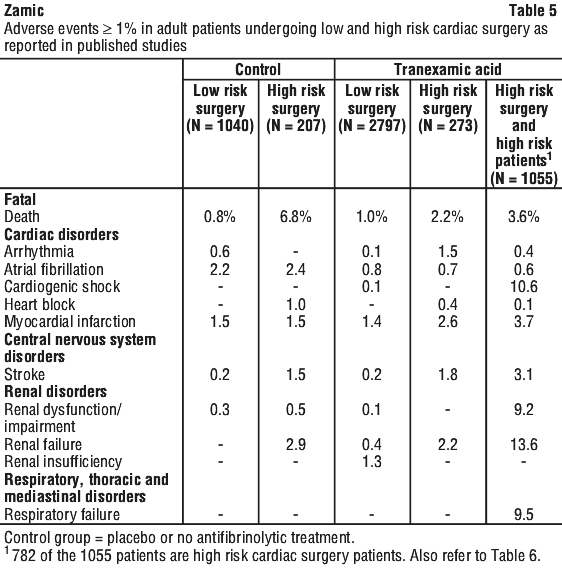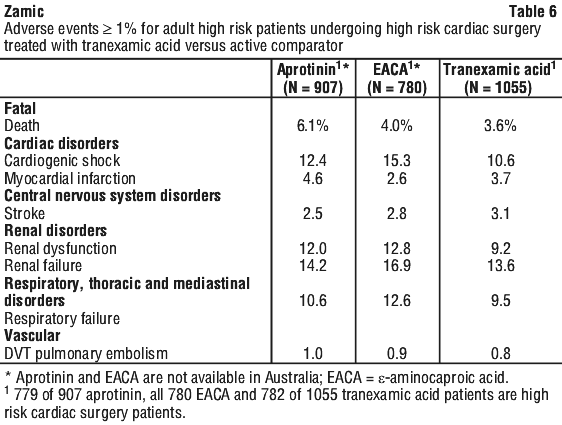SUMMARY CMI
ZAMIC
Consumer Medicine Information (CMI) summary
The full CMI on the next page has more details. If you are worried about using this medicine, speak to your doctor or pharmacist.
1. Why am I given Zamic?
Zamic contains the active ingredient tranexamic acid. Zamic is used to reduce bleeding and the need for transfusion of blood in patients undergoing heart surgery, total knee replacement and total hip replacement surgery.
For more information, see Section 1. Why am I given Zamic? in the full CMI.
2. What should I know before I am given Zamic?
Do not use if you have ever had an allergic reaction to tranexamic acid or any of the ingredients listed at the end of the CMI
Talk to your doctor if you have any other medical conditions, take any other medicines, or are pregnant or plan to become pregnant or are breastfeeding.
For more information, see Section 2 What should I know before I am given Zamic? in the full CMI.
3. What if I am taking other medicines?
Some medicines may interfere with Zamic and affect how it works.
A list of these medicines is in Section 3. What if I am taking other medicines? in the full CMI.
4. How is Zamic given?
Zamic will be given to you by a doctor or nurse as an injection or infusion into a vein.
More instructions can be found in Section 4. How is Zamic given? in the full CMI.
5. What should I know after receiving Zamic?
| Things you should do |
|
| Driving or using machines |
|
For more information, see Section 5. What should I know after receiving Zamic? in the full CMI.
6. Are there any side effects?
Less serious side effects include nausea, vomiting, diarrhoea and giddiness or dizziness. Serious side effects include sudden signs of allergy; fast, slow or irregular heartbeat; heart attack, cardiogenic shock; stroke; convulsions, fits or seizures; kidney problems; difficulty breathing; buildup of fluid in the lungs; deep vein thrombosis; blood clot in your lungs; bowel obstruction; changes in your eyesight.
For more information, including what to do if you have any side effects, see Section 6. Are there any side effects? in the full CMI.
FULL CMI
ZAMIC
Active ingredient(s): tranexamic acid
Consumer Medicine Information (CMI)
This leaflet provides important information about using Zamic. You should also speak to your doctor or pharmacist if you would like further information or if you have any concerns or questions about being given Zamic.
Where to find information in this leaflet:
1. Why am I given Zamic?
2. What should I know before I am given Zamic?
3. What if I am taking other medicines?
4. How is Zamic given?
5. What should I know after receiving Zamic?
6. Are there any side effects?
7. Product details
1. Why am I given Zamic?
Zamic contains the active ingredient tranexamic acid. Zamic is an antifibrinolytic that works by slowing the processes that cause bleeding.
Zamic is used to reduce bleeding and the need for blood transfusion in patients undergoing heart surgery, total knee replacement and total hip replacement surgery.
2. What should I know before I am given Zamic?
Warnings
You must not be given Zamic if:
- you are allergic to tranexamic acid, or any of the ingredients listed at the end of this leaflet.
Always check the ingredients to make sure you can use this medicine. - you are being treated for stroke.
- you have ever had a blood clot in a vein (deep vein thrombosis) or in your lungs (pulmonary embolism) or anywhere else in your body.
- you have a problem with colour vision that developed after you were born.
- the expiry date printed on the pack has passed
- the packaging is torn or shows signs of tampering
Check with your doctor if you:
- or someone in your family, has ever suffered from blood clots
- have severe bruising
- have kidney disease with or without blood in the urine
- have irregular periods and the reason is not known
- have or have ever suffered from convulsion, fits or seizures.
- have allergies to any other medicines
- have allergies to any other substances, such as foods, preservatives or dyes.
During treatment, you may be at risk of developing certain side effects. It is important you understand these risks and how to monitor for them. See additional information under Section 6. Are there any side effects?
Pregnancy and breastfeeding
Check with your doctor if you are pregnant or intend to become pregnant.
Talk to your doctor if you are breastfeeding or intend to breastfeed.
3. What if I am taking other medicines?
Tell your doctor or pharmacist if you are taking any other medicines, including any medicines, vitamins or supplements that you buy without a prescription from your pharmacy, supermarket or health food shop.
Some medicines may interfere with Zamic and affect how it works. These include:
- other medicines used to prevent bleeding
- medicines used to thin the blood
- oral contraceptives.
Check with your doctor or pharmacist if you are not sure about what medicines, vitamins or supplements you are taking and if these affect Zamic.
4. How is Zamic given?
How much is given
Your doctor will decide what dose and how often you will receive Zamic. The dosage you will be given will depend on your weight, what it is being used for and other factors, such as your age, and whether you suffer from diseases relating to the kidneys.
How is it given
Zamic will be given to you by a doctor or nurse as an injection or infusion into a vein.
If you are given too much Zamic
This rarely happens as Zamic will be given to you in hospital under the care of a highly trained doctor. In the unlikely event that you are given too much (an overdose), you may experience some of the effects listed under Section 6. Are there any side effects?. Immediately telephone your doctor or Poisons Information Centre for advice (in Australia telephone 131126, in New Zealand telephone 03 474 7000) or go to Accident & Emergency at your nearest hospital if you think you or anyone else has been given too much Zamic, even if there are no signs of discomfort or poisoning. You may need urgent medical attention.
The signs of overdose are dizziness, headache, nausea, diarrhoea, low blood pressure, convulsions, fits or seizures.
Your doctor has information on how to recognise and treat an overdose. Ask your doctor if you have any concerns.
5. What should I know after receiving Zamic?
Things you should do
Tell your doctor or nurse if you do not feel well after you have been given Zamic.
Driving or using machines
Be careful before you drive or use any machines or tools until you know how Zamic affects you. Tranexamic acid may cause dizziness
Looking after your medicine
Your doctor, pharmacist or nurse is responsible for storing Zamic in a cool dry place, protected from light where the temperature stays below 25°C and disposing of any unused product correctly.
This product does not contain antimicrobial agents. It is for single use in one patient only.
If storage of the diluted solution is necessary, it should be stored at 2°C - 8°C for a maximum of 24 hours.
Any unused solution should be discarded.
6. Are there any side effects?
All medicines can have side effects. If you do experience any side effects, most of them are minor and temporary. However, some side effects may need medical attention.
See the information below and, if you need to, ask your doctor or pharmacist if you have any further questions about side effects.
Speak to your doctor if you have any of these less serious side effects and they worry you.
Less serious side effects
| Less serious side effects | What to do |
| Speak to your doctor if you have any of these less serious side effects and they worry you. |
Serious side effects
| Serious side effects | What to do |
| Call your doctor or nurse straight away, or go straight to the Emergency Department at your nearest hospital if you notice any of these serious side effects. |
Tell your doctor immediately or go to Accident and Emergency at your nearest hospital if you notice any of the following:
- unexpected pain
- unexpected swelling in your legs or arms
- giddiness or dizziness
- allergic skin reactions
- changes in your eyesight
- convulsions, fits or seizures
- low blood pressure from rapid administration of Zamic Solution for Injection.
These may be serious side effects. You may need urgent medical attention. These side effects are rare.
Tell your doctor or pharmacist if you notice anything else that may be making you feel unwell.
Other side effects not listed here may occur in some people.
Reporting side effects
After you have received medical advice for any side effects you experience, you can report side effects to the Therapeutic Goods Administration online at www.tga.gov.au/reporting-problems. By reporting side effects, you can help provide more information on the safety of this medicine.
Always make sure you speak to your doctor or pharmacist before you decide to stop taking any of your medicines.
7. Product details
This medicine is only available with a doctor's prescription.
What Zamic contains
| Active ingredient (main ingredient) | Tranexamic acid 100 mg /1 mL |
| Other ingredients (inactive ingredients) | Water for Injections |
| Potential allergens | NA |
Do not take this medicine if you are allergic to any of these ingredients.
What Zamic looks like
Zamic Solution for Injection is a clear and colourless solution available in packs of 5 x 5 mL ampoules each containing 500 mg tranexamic acid and 5 mL Water for Injections.
Australian Registration number: AUST R 202786
Who distributes Zamic
Medsurge Pharma Pty Ltd
Unit 1&2, 6-7 Gilda Court
Mulgrave, VICTORIA
Australia 3170
Marketed and Distributed by Medsurge Healthcare Pty Ltd.

Telephone: 1300 788 261
Website: www.medsurgehc.com
This leaflet was prepared in March 2025.
Published by MIMS May 2025






 The incidences of DVT or pulmonary embolism for all three treatments were low (1.0 to 1.3%).
The incidences of DVT or pulmonary embolism for all three treatments were low (1.0 to 1.3%).
 Only one study included in the meta-analysis examined the effect of different doses of tranexamic acid on postoperative blood loss and blood product requirements. In this study, 150 children were assigned, 30 per group, to the following 5 groups: Group A: the control group (who did not receive any tranexamic acid); Group B: who received 50 mg/kg of tranexamic acid at induction of anaesthesia; Group C: 10 mg/kg at induction followed by an infusion of 1 mg/kg/h; Group D: 10 mg/kg at induction, 10 mg/kg at bypass and 10 mg/kg after protamine; Group E: 20 mg/kg at induction and after protamine.
Only one study included in the meta-analysis examined the effect of different doses of tranexamic acid on postoperative blood loss and blood product requirements. In this study, 150 children were assigned, 30 per group, to the following 5 groups: Group A: the control group (who did not receive any tranexamic acid); Group B: who received 50 mg/kg of tranexamic acid at induction of anaesthesia; Group C: 10 mg/kg at induction followed by an infusion of 1 mg/kg/h; Group D: 10 mg/kg at induction, 10 mg/kg at bypass and 10 mg/kg after protamine; Group E: 20 mg/kg at induction and after protamine. Tranexamic acid is a white crystalline powder freely soluble in water and in glacial acetic acid, practically insoluble in methanol, ethanol, acetone, diethyl ether and benzene.
Tranexamic acid is a white crystalline powder freely soluble in water and in glacial acetic acid, practically insoluble in methanol, ethanol, acetone, diethyl ether and benzene.